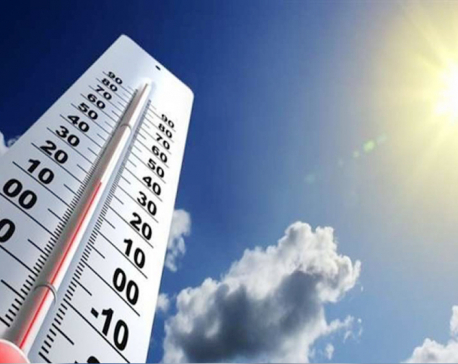
OR
Scientists: The next five years could be seriously hotter than normal
Published On: August 15, 2018 12:00 PM NPT By: Agencies

The past four years have been the four warmest ever recorded - and now, according to a new scientific forecast, the next five will also probably be "anomalously warm," even beyond what the steady increase in global warming would produce on its own.
That could include another record warmest year, even warmer than the current record year of 2016.
It could also include an increased risk of heat extremes and a major heat event somewhere Earth's oceans, of the sort that have triggered recent die-offs of coral reefs across the tropics.
"What we found is that for the next five years or so, there is a high likelihood of an anomalously warm climate compared to anomalously cold," said Florian Sevellec, a scientist at France's National Center for Scientific Research, who co-authored the study published in Nature Communications with Sybren Drijfhout of the University of Southampton in the United Kingdom.
Earth is warming, but this does not mean that every year is warmer than the previous one.
Rather, there is an overall warming trend - meaning that each successive decade tends to be warmer than the last - but also plenty of bouncing around among individual years in how hot they get.
One key determinant of a year's temperature is what scientists sometimes call the climate's "internal variability," as opposed to the contribution of human-released greenhouse gases.
The new forecast for 2018 through 2022 arises from projecting how this internal or natural variability will play out.
During the global warming "hiatus" during the 2000s, for instance, these internal factors, such as oscillations in Earth's oceans, helped keep the planet somewhat cooler than it might otherwise have been and blunted the pace of warming - launching a long-running scientific debate and 1,000 political talking points.
Now, though, these same internal factors are poised to do the opposite, says the new research (whose authors also note that their technique can successfully capture the earlier "hiatus").
And assuming that the steady rate of global warming continues, that means already rising temperatures will get an added boost.
The study mines data from 10 existing climate change models, or simulations, to determine which do the best job of capturing how natural factors are contributing to the planet's temperature.
Then it projects forward using the same simulations to see how these factors will play out over the next five years.
It's important to underscore that the result is a forecast based on probability - not a certain outcome.
The study finds a 58 percent chance that the Earth's overall temperature from 2018 through 2022 will be anomalously warm based on these factors, and a 69 percent chance that Earth's oceans will be.
This includes, for Earth's oceans, "a dramatic increase of up to 400 percent for an extreme warm event likelihood" during 2018 to 2022, the study reports.
Already, 2018 is shaping up to be a pretty warm year - although not record-breaking.
For instance, the period from March through May of this year was 0.87 degrees Celsius (1.57 degrees Fahrenheit) above the planet's average from 1951-1980, making that the third-warmest such stretch in the temperature record, according to NASA's Goddard Institute for Space Studies.
It's too early to determine where the year as a whole will rank. According to NASA, 2016 was the warmest year on record, followed by 2017, 2015 and 2014.
Two scientists that The Post asked about the new research had different views.
The study "offers a new and promising low-cost approach to forecasting near-term variations in global average surface temperature," said John Fyfe, a climate scientist at the Canadian Centre for Climate Modelling and Analysis.
"Results indicate that internal variations in the climate system will likely cause the surface to warm substantially above that expected from increasing greenhouse gases in the atmosphere - at least for the next five years. This is important information for scientists, policymakers and society writ-large."
But Gavin Schmidt, who directs the NASA Goddard Institute for Space Studies, said that the size of the effect isn't very large, noting that for 2018, the technique predicts just two hundredths of a degree Celsius of added warming for the planet as a whole.
"Let's be clear, being 58 percent confident that 2018 will be 0.02 degrees Celsius above the forced trend . . . is not practically significant (even if it might be skillful)," Schmidt wrote in an email.
He also noted that the central factor in determining unusual warmth in any given year is whether it is an El Niño year - as 2016 was. But while scientists are monitoring whether the Earth is or isn't trending toward El Niño, the study does not attempt to predict that.
Schmidt also questioned whether the warm incursion implied by the new study would be as significant an event as the global warming "pause" or "hiatus" of the 2000s.
"Note that the 'hiatus' was an issue because it went against the mainstream narrative, a slightly higher couple of years won't. And as we have stressed for decades, it's the long-term trends that matter," he wrote.
There's one thing nobody can deny - the next 54 months (including this July, for which the temperature has not yet been reported by NASA) will definitively test the new forecast.
"It is one study, and what will be interesting is that now there will be a lot more that we'll also test and try to see if our prediction is right or not," Sevellec said.
You May Like This

Temperature in Kathmandu Valley to remain high today as well
KATHMANDU, June 13: Weather in the eastern part of the country is currently experiencing an influence of the monsoon system.... Read More...

Cold affects normal life, morning flights disrupted in Banke
NEPALGUNJ, Dec 25: Normal life in Banke district has been affected due to a cold wave and thick fog. Banke district... Read More...

Country feels the chill as temperature drops
Kathmandu, Jan 4: With the minimum temperature plummeting to 1.5 degree Celsius, Kathmandu valley today experienced the coldest day of... Read More...











Just In
- Challenges Confronting the New Coalition
- NRB introduces cautiously flexible measures to address ongoing slowdown in various economic sectors
- Forced Covid-19 cremations: is it too late for redemption?
- NRB to provide collateral-free loans to foreign employment seekers
- NEB to publish Grade 12 results next week
- Body handover begins; Relatives remain dissatisfied with insurance, compensation amount
- NC defers its plan to join Koshi govt
- NRB to review microfinance loan interest rate







Leave A Comment